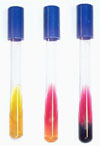The bacteria quickly metabolized the glucose, initially producing an acid slant and an acid butt (acid over acid; A/A) in a few hours. The Emben-Meyerhof-Parnas pathway was used both aerobically (on the slant) and anerobically (in the butt) to produce ATP and pyruvate. On the slant, the pyruvate was further metabolized to CO2, H2O, and energy. After further incubation (18 hours) the glucose was consumed, and because the bacteria could not use lactose or sucrose, the peptones (amino acids) were utilized as an energy source aerobically, on the slant. Utilization of peptones causes the release of ammonia (NH3) resulting in the pH indicator, phenol red, turning from yellow to red. In the anerobic butt, the bacteria use the Embden-Meyerhof-Parnas pathway to metabolized the glucose producing ATP and pyruvate, which is converted into stable acid endproducts, thus the butt remains acidic. The results would be recorded as alkaline over acid (K/A).
Bacteria producing an K/A reaction with or without gas include: Citrobacter freundii* , Citrobacter koseri*, and Morganella morganii*.
* = variable reactions
Reference: MacFaddin, J.F. (2000) Biochemical Tests for Identificaion of Medical Bacteria, 3rd. ed. Lippincott Williams & Wilkins, Philadelphia. |

